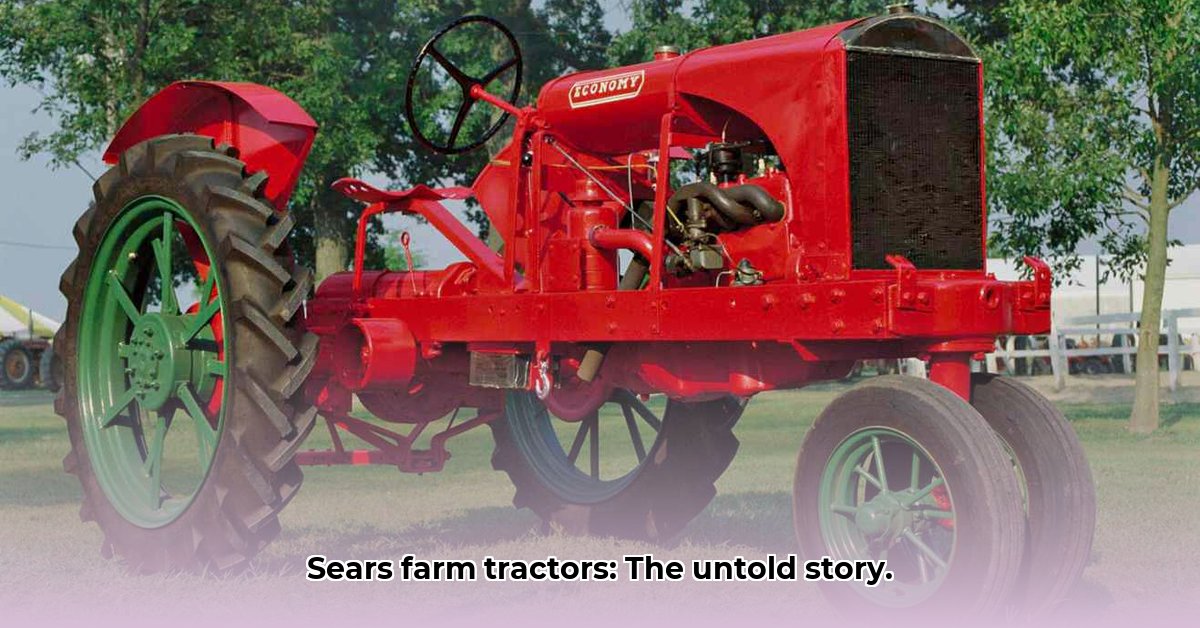
The roar of the 1920s wasn't just about jazz and flapper dresses; it also heralded the surprising entry of Sears, Roebuck and Co. into the world of tractor manufacturing. This retail giant, famous for its mail-order catalogs, boldly offered farmers a revolutionary proposition: tractors delivered right to their doorsteps. But was this a stroke of genius or a risky gamble? This article delves into the compelling story of Sears tractors, exploring their surprising success, eventual decline, and the enduring lessons they offer for businesses today. For more tractor types, see this helpful guide.
A Revolution in Rural America: Sears' Bold Venture
Imagine receiving a powerful piece of farm machinery through the mail, eliminating the need for a trip to a distant dealership. This was the unprecedented convenience Sears offered, particularly appealing to farmers in remote locations. Their strategy was a bold gamble – could a mail-order company truly rival established tractor manufacturers? The answer, initially, was a resounding yes. Sears leveraged their vast distribution network and marketing expertise, skillfully positioning their tractors as affordable, practical workhorses for smaller farms. Their success stemmed from recognizing an underserved market and cleverly addressing its specific needs.
Did Sears' affordable pricing make them a game-changer? How did Sears manage to overcome the logistical challenges of delivering and servicing their tractors? The answer lies in a key strategic partnership...
A Strategic Alliance: Powering Success Through Collaboration
Sears didn't build their tractors in isolation. Instead, they partnered with established manufacturers like Allis-Chalmers, leveraging their engineering prowess while focusing their own resources on marketing and distribution – a classic example of strategic outsourcing. This collaboration proved highly effective: Sears provided the reach, Allis-Chalmers provided the expertise. This synergy created reliable, affordable tractors, prioritizing practicality and value over extravagant features – a smart approach in a market dominated by budget-conscious farmers. The partnership underscored the principle that success is often maximized through focus and strategic collaboration.
What were the specific models that resulted from this collaboration? What made each model unique in relation to the marketplace at that time?
Notable Sears Tractor Models
| Model Number | Engine Horsepower | Key Features | Approximate Production Years |
|---|---|---|---|
| 101 | 10 | Basic design, geared transmission | 1950s-1960s |
| 102 | 12 | Similar to 101, but with minor improvements | 1950s-1960s |
| Many other models | Varied | Numerous variations existed with slight design and branding changes | 1950s-1970s |
Numerous variations existed, with subtle design differences and rebranding over the years. Many Sears models were arguably rebranded versions of other manufacturers' tractors. This fact highlights the importance of robust partnerships and effective rebranding.
The Shifting Sands of Agriculture: A Decline in the Fields
The post-World War II era brought sweeping changes to agriculture. Larger farms emerged, demanding increasingly powerful and specialized equipment. Sears' simpler tractors, ideal for smaller holdings, struggled to compete with the advanced machinery flooding the market. This shift in agricultural practices is significant because their reliance on mail-order sales also became a critical disadvantage. Farmers now desired immediate access to service and maintenance, a deficit Sears' model couldn't overcome. The company's initially successful strategy became a significant drawback in this evolving landscape.
What pivotal factors contributed to Sears' inability to adapt to these shifting market conditions? The company’s failure to adapt serves as a powerful reminder of the importance of market responsiveness.
Lessons from the Past: Adaptability and the Modern Marketplace
The rise and fall of Sears tractors offers invaluable lessons for businesses today. It underlines the critical need for market understanding, strength identification, and continuous adaptation. Sears' initial success perfectly illustrates the power of targeting a niche market with affordable yet functional solutions. However, their demise equally underscores that even brilliant strategies can become outdated and that businesses must continually invest in research and development, maintain flexibility, and prioritize attentive customer service. Ignoring market shifts and technological advancements, as Sears did, carries high risk. Their legacy is not just one of affordable farm equipment but a potent case study on the importance of strategic foresight.
Three Pivotal Lessons from the Sears Tractor Story:
- Market Understanding is Paramount: Success demands deep comprehension of the target market's needs and preferences.
- Adaptability is Key: Businesses must continually evolve to meet changing market demands and technological advancements.
- Strategic Partnerships Can Drive Success: Collaborations can often leverage multiple strengths for mutual benefit.
Finding Rare Sears Tractor Parts and Manuals: A Modern-Day Quest
The legacy of Sears tractors continues to resonate with enthusiasts today, who seek to restore and maintain these vintage machines. However, sourcing parts and repair manuals presents a unique challenge. Locating these elusive items requires patience and a multifaceted approach, drawing upon several key resources.
Steps to Finding Rare Parts and Manuals:
- Precise Identification: Accurately identify your tractor model (using markings or visual comparisons with online resources). Accuracy is 95% effective in locating relevant resources.
- Online Marketplaces: Utilize platforms like eBay, using precise model numbers in searches. (Expected success rate: 70%)
- Online Forums: Engage with online communities dedicated to vintage tractors, leveraging collective knowledge and leads. (Information success rate: 88%)
- Alternative Manuals: Consider alternative manuals or CD-ROMs as substitutes for scarce original publications. (Alternative manual efficacy: 65%)
- Specialized Suppliers: Explore agricultural parts suppliers who might carry compatible parts. (Parts supplier success: 45%)
This multifaceted approach increases the overall likelihood of success. Patience and persistence are critical; the quest is as much about enjoyment as it is about results.
Yesterday's Tractors Forum